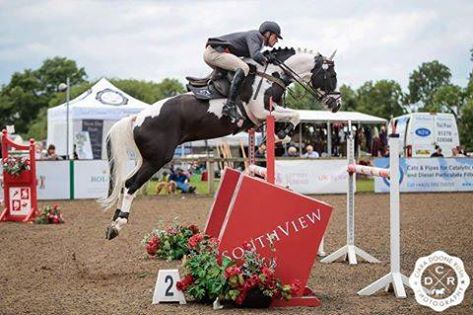Rantzau xx
Frenchman, Henri Tambareau, was a vet, an ex-racing jockey, and a breeder. Not one of the wealthy breeders with field full of expensive broodmares in foal to fashionable stallions, but a man who liked to purchase inexpensive mares and breed them to less expensive stallions.In 1943 he purchased Rancune, who had won several times on the racetrack and who came from an excellent family. Her dam, Rockella, is by Bishop’s Rock, a son of Teddy who carries the great jumping blood of Bay Ronald on his dam line.
At stud, Rancune produced only winners, three of them by the stallion, Foxlight.
Foxlight was the star of the famed French stallion station, Haras du Pin. A very ‘chic’ chestnut roan, he had won and placed in classic races before being retired to stud, where he was immediately successful.
According to Jean Delannoy in the superb feature on Rantzau, in the Annuaire du Cheval de Sport and d’Elevage, 2000 {for information on this annual publication which appears in French and English, contact river@magic.fr } “Like many of the public stallions, Foxlight was not used by the big breeders who preferred to spotlight their own stallions and so he was much more often in the top ten sires of steeplechasers than in the top ten sires of flat winners. Commandant Marchal, a great theoretician of Thoroughbred, easily admitted that the ‘bureaucrats’ were more often successful in this speciality than in flat racing because their sires were chosen with more balance than the private sires. If Foxlight was not a ‘crack’ he had very solid bloodlines which both we and stud farms like. He was a distance runner (Prix du Cadran = 4,000 metres} and he came by it honestly.
As a little erudition never hurt anyone, let’s take a look at his bloodlines which go back directly to Eclipse: Darley Arabian (1700} – Bartlett’s Childers (1716} – Squirt (1732} – Marske (1750} – Eclipse (1764} – Pot 8 Os (1773} – Waxy (1790} – Whalebone (1807} – Camel (1822} – Touchstone (1831} – Newminster (1848} – Lord Clifden (1860} – Hampton (1872} – Bay Ronald (1893} – Dark Ronald (1905} - Son in Law (1911} - Foxlaw (1922} - Foxhunter (1829} – Foxlight (1935}.” Bay Ronald breeding yet again!
Bred to Foxlight, Rancune produced Rantzau in 1946. Rantzau was a solid performer on the track, rated three of his three-year-old generation, with 9 races between 2,000 and 3,000 metres. He won two and was placed five times. He was purchased by Marcel Boussac at the end of his 3-year-old season, and sold to the National Stud. On January 5th, 1951, he arrived at Saint-Lo.
The stud inspector at the time, commented: “good front extension, remarkably built through the shoulder and forearm, long haunches, this classy stallion of rare nobility also has low-placed joints and covers ground.
He was welcomed by the breeders and between 1951 and 1962, bred between 40 and 49 mares a year. In those days, stallions only had permission to breed 40 mares a year, plus the National Stud director’s cards used by him ‘in the interest of breeding’.
In 1959 the Inspector noted ‘his get have good jumping ability’. In 1963, it was noted that he was ‘high off the ground, with slightly long cannon bones and slightly straight and interiorly bony hocks; but he has a very lovely look, a good frame, good muscle tone, a well-angled should and he is well muscled. His get have good jumping ability.’
In later years, Rantzau was less used, but in all, in 20 years of breeding, he covered 772 mares, for an average of 38 a year.
By 1958, Rantzau was ranked 17th on the list of top showjumping sires, by 1962, he had moved to 11th spot, and by 1963, he was 5th behind Foudroyant II, Furioso, Nithard and Brûle Tout. Next year, he had moved into 2nd place behind Furioso, thanks in part to Labrador C, who was now ranked 3rd amongst the aged horses, behind the Olympic gold medallist, Lutteur B (Furioso}.
Rantzau’s fame was spreading, Medrano was winning for Holland, and a Thoroughbred, Cour d’Appel (Foxlight out of a daughter of Cor de Chasse} won for Spain at the CSIs of Madrid, Barcelona and Biarritz. Holland and Switzerland were buying Rantzaus. The following year Labrador C’s full-brother, Osiris C is third on the aged standings, just in front of Labrador C, with Luxeuse B in 12th. Rantzau is still in no 2 position on the rankings. Internationally, Nageur (out of Harmonie by Beau Reve} had wins in Lisbon for Portugal, and Pascha du Bourg won an Italian CSI for Spain.
1966 and it is more of the same in France, and he holds second, while internationally, the five (!} year old Radar II is winning CSIs for Italy with the famous Piero d’Inzeo, Medrano is starring for Holland, Nageur for Portugal, and Pascha du Bourg for Spain. Rantzau holds his 2nd spot in 1967, 68 and 69.
In 1970 the rankings are upgraded and the standings for the ‘best sires of dams’ are published for the first time. Rantzau is ranked 3rd of the sires of winners, behind Ibrahim and Furioso. Finally in 1971, Rantzau makes it to the top, ranked in front of Ibrahim and Furioso, thanks to the now 16-year-old Labrador C, along with Roi du Manoir, Osiris C, Prince Royal, Sire du Logis, Amour de Juilley, etc.
Rantzau is now ranked the 5th best sire of Eventers thanks largely to Quolibet Z and Unic F. The following year he holds onto top spot and interestingly for the future his son, Starter (dam sire of Baloubet du Rouet} is moving up on the stallion rankings, 67th thanks to the performance of Beau Fixe in the 5 year olds. In 1973, Rantzau surrenders number one to Ibrahim, but despite that fact that he has been dead for two years, the Thoroughbred continues to hold his spot – and even in 1980, he is in 4th place behind Uriel, Almé and Nankin. His son, Starter has moved up 13th, Kalmiste is 31st (and 6th of eventing sires}, Quelqu’un is 78th, Venutard is 8th of the dressage stallions.
In 1981, ten years after he died, Rantzau finally made it to number one on the Sire of Dams rankings. Of his sons in France, Starter moved into the top ten in 1985, and headed the rankings in 1988-89-91-93, 4th in 1994 and 6th in 1996.
In Europe, Cor de la Bryère, born in 1968 out of a mare by the Furioso xx son, Lurioso, has without doubt been the most influential son of Rantzau, establishing one of the two mighty C lines that dominate Holstein – and jumping – breeding to this day.
The importance of the Thoroughbred in French breeding is summed up well by French jumping star, Michel Robert in the 1994 L’Eperon Special Breeding publication, Credo for the Thoroughbred:
“The error has been to set aside Thoroughbreds, Anglo-Arabs and Trotters, or, in any event, not to look for them because it was thought that they would bastardise the race… I am suspicious of ‘pure blood’ Selle Français horses with only far removed Thoroughbred ancestry, because I know they are going to lack ‘gasoline’. I believe that my opinion is shared by all of the other high-level competition riders. If they have a complaint about their horses, it’s often ‘at the jump off, he won’t move forward’, it’s that the horse lacks ‘blood’. The utilization of the Thoroughbred and Anglo-Arab should be accentuated in the maternal bloodlines and with the stallions… we should ideally have Thoroughbred stallions with showjumping performances which could become the new foundation sires to get the ideal cross, I would take a dark brown Thoroughbred stallion with a lot of strength, a show winner, with depth, length, a little tough, a Thoroughbred which could do three day events, and I would cross him with a dam from the Ibrahim line, or vice versa. The Ibrahims were jumpers with a lot of strength in their backs and a classical style.
Almé was a phenomenal horse in his propulsion, he passed his hindquarters in a manner rarely found in our French horses. He should be used for his strength of hindquarters, but crossed with Thoroughbred or Anglo-Arab to infuse class and agility. What at one time saved the French breeding industry was the fact that Thoroughbreds such as Furioso or Ranzau were brought here, who truly marked our breeding and who were the base for the show bloodlines. I am convinced that to make crack horses, we need horses with Thoroughbred or Anglo-Arab in their breeding. A good horse must be fast, careful, brave, with a lot of power.”
Jean Delannoy sums up at the end of his tribute: "People who knew the Rantzaus (Marc Houssin, Michel Pelissier, Remy Thault, Emille Esnault} remember horses who were sometimes sensitive, but perfectly usable. They were cold to the girth when being broken, and the mares in heat could be very susceptible. They needed to gain confidence and it was necessary to completely dominate them, but without brutality. Often stiff and sttrong with straight hocks, a tight back, they were very generous, sure of themselves and cold to the leg. Even today it is easy to recognize a Rantzau descendant because of their chic look, occasional black leopard spots, sometimes white hairs, and their famous straight hocks."



